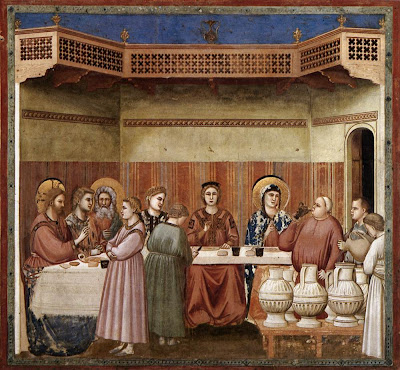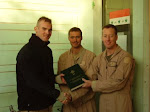
Isaiah 62: 1-5; Psalm 96, 1-3, 7-10; 1 Corinthians 12: 4-11; St. John 2: 1-11
Our Lady has interceded for those who approach her divine Son from the very beginning of his public life and ministry.
Mary was invited to a wedding at Cana, and "Jesus also was invited to the marriage with his disciples". Our Lady informs Jesus "they have no more wine". Though he hesitates, saying "My hour has not yet come", he yet accedes to her wishes and the needs of the wedding guests and changes water into wine upon our Lady's instruction to the servants: "Do whatever he tells you." We also are invited by our Lady to render obedience to her Son: "in that all Christian holiness consists: for perfect holiness is obeying Christ in all things". (St. Thomas Aquinas, Comm. on St. John, in loc.).
In the public life of Jesus Mary appears prominently; at the very beginning when at the marriage feast of Cana, moved with pity, she brought about by her intercession the beginning of the miracles of Jesus the Messiah (cf. John 2: 1-11). In the course of her Son's preaching she received the words whereby, in extolling a kingdom beyond the concerns and ties of flesh and blood, he declared blessed those who heard and kept the word of God (cf. Mk 3:35; Lk 11:27-28) as she was faithfully doing (cf. Lk 2:19; 51). Thus the Blessed Virgin advanced in her pilgrimage of faith, and faithfully persevered in her union with her Son unto the cross, where she stood (cf. Jn 19:25), in line with the divine plan, enduring with her only begotten Son the intensity of his passion, with his sacrifice, associating herself in her mother's heart, and lovingly consenting to the immolation of this victim which was born of her. Finally, she was given by the same Christ Jesus dying on the cross as a mother to his disciple, with these words: 'Woman, behold thy son' (Jn 19: 26-27)" (Second Vatican Council, Lumen gentium, 58).
|
"At Cana, Mary appears once more as the Virgin in prayer: when she tactfully told her Son of a temporal need, she also obtained an effect of grace, namely, that Jesus, in working the first of his 'signs', confirmed his disciples' faith in him." (Paul VI, Marialis cultus, 18).
Why are Mary's prayers so effective with God? The prayers of the saints are prayers of servants, whereas Mary's are a Mother's prayer, whence flows their efficacy and their authority; and since Jesus has immense love for his Mother, she cannot pray without being listened to...To understand Mary's great goodness, let us remember what the Gospel says...There was a shortage of wine, which naturally worried the married couple. No one asks the Blessed Virgin to intervene and request her Son to come to the rescue of the couple...; it stirs her to act as intercessor and ask her Son for the miracle, even though no one asks her to...If our Lady acted like this without being asked, what would she not have done if they actually asked her to intervene?" (St. Alphonsus Mary Ligouri, Sunday Sermons, 48).
|
By God's design Mary is uniquely a Mediatrix for us, our Mother in the order of grace (CCC 967-970) just as she was for the wedding guests at Cana. No other creature shares in the privileges she enjoys as cooperator in the work of her Son.
"This motherhood of Mary in the order of grace continues uninterruptedly from the consent which she loyally gave at the Annunciation and which she sustained without wavering beneath the cross, until the eternal fulfillment of all the elect. Taken up to heaven she did not lay aside this saving office but by her manifold intercession continues to bring us the gifts of eternal salvation...Therefore the Blessed Virgin is invoked in the Church under the titles of Advocate, Helper, Benefactress, and Mediatrix." (Second Vatican Council, Lumen gentium, 62) (CCC 969)
|
Blessed Lady, intercede for us that we may do whatever the Lord tells us and so may, like the wedding guests at Cana, see his glory and believe in Him.
Let's pray for each other until, together next week, we "meet Christ in the liturgy", Father Cusick
(See also nos. 486, 495, 1335, 1613, and 2618 in the Catechism of the Catholic Church.)
(Publish with permission.)








No comments:
Post a Comment